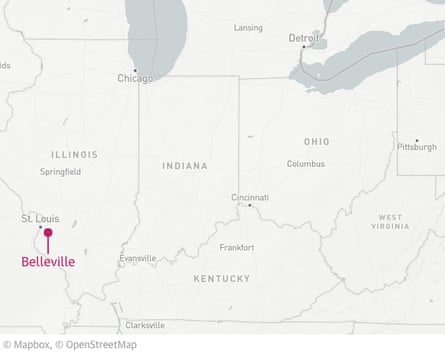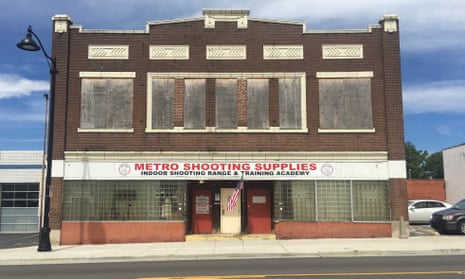Behind an immaculately kept lawn and a neat gravel pathway, the unassuming two-storey house almost seemed like any other along the lane in Belleville, Illinois. If it weren’t for the FBI agents, who had been parked outside for 24 hours, and the small army of reporters camped on the roadside, none of the neighbours would have assumed anything untoward.
The homeowner, James Hodgkinson, “kept himself to himself”, said a 59-year-old next-door neighbour who did not want to be named. In the 20 years Hodgkinson had lived just two houses from William Schaumleffel, the two men had never spoken. Hodgkinson didn’t wave back when Schaumleffel, 77, would greet him on occasion. It was odd, thought Schaumleffel, “but some people like their privacy”.

On Wednesday, Hodgkinson opened fire on a Republican congressional baseball practice in Virginia, critically injuring senior GOP congressman Steve Scalise and three others, and later dying of his injuries. As the 66 year-old joined the increasingly long list of Americans involved in barbaric acts of mass gun violence, the shooting reinvigorated the conversation about the tenor of debate in US politics after it emerged Hodgkinson likely deliberately targeted the politicians due to their political party. He had also articulated ardent criticism of Donald Trump’s election victory on social media.
As Sue Hodgkinson, the 64-year-old widow of the gunman, emerged from her home to face the press for the first time since the attack, clutching the arms of a St Clair County deputy sheriff in the intense humidity, she was unable to offer much insight into what might have motivated her husband to carry out such an act of brutality.

“I just don’t know what I want to tell you people,” she said, her voice cracking and her small frame almost dwarfed by the microphone stand in front of her. “I had no idea this was going to happen and I don’t know what to say about it. I can’t wrap my head around it.”
A blurred picture of the shooter’s background and potential motivation has begun to emerge following interviews with neighbours and family members that confirmed his violent past, staunch political views and reclusive nature.

Hodgkinson, who also went by the name Tom, had left the property in Belleville in late March after selling his local home inspection business and other assets. He told his wife he had gone to Washington to “work with people to change tax brackets” and never returned.
The 66-year-old had long advocated for tax reform, writing letters to the local paper, between 2008 and 2012, in which he argued against Reagan-era economics and advocated for the legalization of cannabis. In 2011 he attended a local Occupy Wall Street protest and told a TV news crew: “The 99% are getting pushed around and the 1% are just not giving a damn.”
St Clair County, where Belleville is the largest city, has for decades voted for Democrats, although the margins are nowhere near as large as they are further north in Chicago. The divisive nature of the 2016 campaign was felt no more acutely here than anywhere else in the country, and residents along Hodgkinson’s lane said there was little discussion of politics throughout 2016. “We didn’t talk about politics or religion. People got their own beliefs and that’s their right,” said the next-door neighbour, who openly identified as a conservative.
Local progressive activist groups too said they had never encountered the gunman previously, and the extent of his volunteering for the Bernie Sanders campaign in the 2016 Democratic primary remains unclear.
“Toxic masculinity and white privilege are the underlying themes of so many incidents like these,” said Stuart Keating, a spokesman for the Democratic Socialists of America St Louis chapter, which represents members in Belleville. “Until we address the systemic cause of incidents like these, we are not likely to see a reduction in such violence.”
An employee at the county commission said they had never seen him attend local government meetings and the largest gun store in town, Metro Shooting Supplies, said Hodgkinson was not a customer and had never used their firing range.
Those closer to Hodgkinson said he exhibited little interest in others, even those in his own family, and he remained reclusive during rare social gatherings.
“He was kind of aloof, he wasn’t friendly,” said Victoria Knepper, whose foster son married Hodgkinson’s foster daughter, Tasha, two years ago. (Another of Hodgkinson’s foster daughters, Wanda Ashley Stock, killed herself at 17 in 1996, according to the Belleville News-Democrat.) “I voted for Trump, so I’m sure I would have got an earful if he knew,” she said. “But he didn’t. He never talked about that [politics].”

Knepper said the gunman would often sit alone in another room in front of a computer or in his garden shed during family gatherings.
He was not present at his foster daughter’s wedding and “wasn’t a very big father figure”.
“It was mostly Sue wanting to adopt and he just went along with it,” Knepper said.
In 2006 Hodgkinson was arrested for domestic assault and discharging a firearm after reportedly beating his foster daughter and two of her friends. The police report said he threw her around a room, pulled on her hair and hit her. He then fired a shotgun round as her friends ran away. The charges were later dismissed.
According to a recent analysis of mass shootings between 2009 and 2016, defined as events where four or more people are shot and killed, 42% of shooters exhibited “red flags” like this. Although the attack in Virginia was not domestic violence, 54% of mass shootings were somehow related to family or domestic violence.
Tasha, and her two-year-old son, had recently moved back into the family home after her marriage broke down. At the press conference outside the house in Belleville, Sue Hodgkinson said the stress of the move-in may also have prompted her husband to leave.
“He was home all day long and he just wanted a break,” she said.
Immediately after Hodgkinson was named as the shooter, his wife Sue sent Knepper a text.
“She said: ‘I knew I had lost him. But now I’ve really lost him.”’
Just days before he left for Washington in March, police were called to his home after Schaumleffel reported he had been firing dozens of rounds from a high powered firearm out in his yard. He had pointed his weapon out towards a wooded area and the shots rang out across the lane.
Schaumleffel’s two young grandchildren were playing close by in the yard and he rushed them inside after Hodgkinson did not stop firing.
“I yelled at him, I said: ‘don’t shoot over there, there’s houses on the other side of the trees’. But you know he didn’t act like he’d even heard me,” Schaumleffel recalled. According to a police report Hodgkinson was found to have a valid firearm license but was told not to fire into the wooded area again.
It was the first and last interaction Schaumleffel and his neighbour would ever have.
